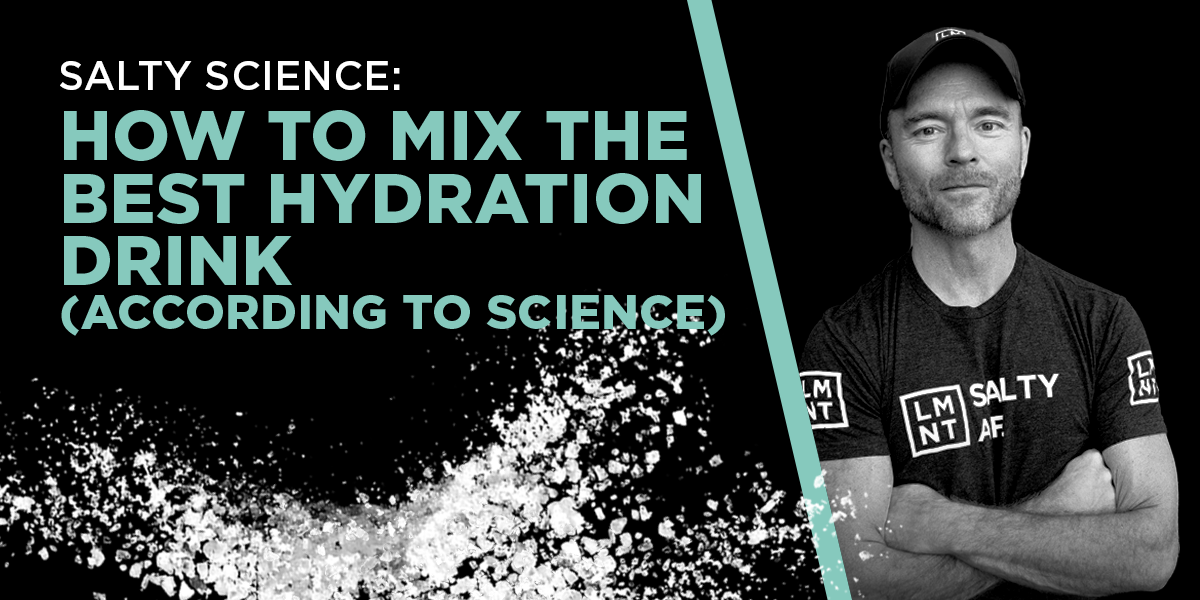When someone says “I need to hydrate,” they usually mean “I need to drink more water.” But water is not the best hydration drink. It’s necessary to stay hydrated, but it’s not sufficient by itself. Allow me to explain.
When you rehydrate with plain water, you neglect a crucial component of fluid balance: electrolytes. It’s like topping up the fluids in your car, but neglecting your oil. The machinery won’t run well.
“But isn’t that what sports drinks are for?” someone might retort. “For athletes to rehydrate after sweat loss?” The problem is, sports drinks were designed decades ago, back when we didn’t understand the harmfulness of chronic high sugar intake. (The risk of nearly every chronic disease goes up.) Sports drinks may hydrate you better than plain water, but the cost of hydration via sugar-laden sports drinks is steep.
Sports drinks also typically don’t contain enough electrolytes. Athletes lose 3.5 to 7 grams of sodium on a hot day, not the few hundred milligrams in most sports drinks or electrolyte powders (and good luck finding a drink with a decent hit of potassium or magnesium).
Well, it’s your lucky day. You’re in the right spot to learn about hydration drinks that are:
- Free of sugar and artificial junk
- Stocked with the necessary electrolytes
- Super convenient (no chemistry or cleanup required)
Spoiler alert: mixing an electrolyte drink with LMNT checks all these boxes. But if you want to learn the ins and outs of hydration, why electrolytes matter, how much of each electrolyte you need, and the scientific evidence behind the creation of an ideal hydration drink, keep reading!
What It Means To Stay Hydrated
One definition of hydration? The act of drinking water. That’s how most people use the term.
But I prefer the more functional, textbook-style definition: “maintaining adequate fluid in bodily tissues.” Maintaining a state of fluid balance is the Holy Grail of hydration.
Most fluid balancing occurs automatically. Your body has many systems that do the yeoman’s work behind the scenes. Let me share some examples.
Fluid Balance on Autopilot Examples:
- If you don’t consume enough fluid, your brain secretes antidiuretic hormone (ADH) to shut down urinary water loss.
- If you consume too much fluid, your brain suppresses ADH.
- If you don’t consume enough sodium (sodium is also crucial for fluid balance), your kidneys secrete aldosterone to retain that mineral.
Thirst is another fluid balancing system that’s partly on autopilot. If you’re dehydrated, receptors in your brain detect your falling blood volume and make you thirsty. When you drink something, the thirst dissipates.
Because thirst is tightly regulated, drinking when thirsty is an excellent strategy for staying hydrated. But that’s only half the strategy.
Why Electrolytes Matter
To stay hydrated, you must consume both fluids and electrolytes. Most people get enough fluids, but fall short on electrolytes.
The primary electrolytes that regulate fluid balance (aka hydration) are sodium and potassium. Your status for both minerals dictates the amount of water inside and outside your cells. But this only scratches the surface of why electrolytes matter. Let’s get acquainted with the sodium-potassium pump to go deeper.
You’re already acquainted with the sodium-potassium pump because it resides in EVERY cell in your body. It’s how cells use energy, communicate with one another, and transport nutrients. The sodium-potassium pump is essential to our existence.
Why do you think electrolyte imbalances bring such disturbing symptoms? (Endurance athletes running low on blood sodium, for instance, can experience confusion, light sensitivity, lethargy, and even seizures.) It’s because electrolytes are the oils that grease the machinery of life. (Is he really using that analogy again?)
Even milder deficiencies can cause problems. The signs and symptoms of electrolyte deficiency—cramps, bone density issues, elevated blood pressure, low energy—can be subtle, but they can also seriously diminish your quality of life. Let’s talk about how to prevent those deficiencies.
Base Electrolyte Needs
Most people don’t get enough electrolytes. (Especially sodium.) But how much is enough?
Sodium Needs
The FDA recommends limiting sodium intake to 2.3 grams per day in order to reduce the risk of cardiovascular disease. Because of this, many people fear the salt shaker.
But data from the prestigious Journal of the American Medical Association show that 4–6 grams of sodium per day is the sweet spot for minimizing the risk of stroke and heart attack. And 4–6 grams is just a starting point. If an athlete loses 7 grams of sodium through sweat, 4–6 grams per day won’t cut it. Heavy sweaters, those who eat whole foods, and low-carb dieters will need increase that amount. Whole foods diets are low in salt (as opposed to processed foods), and low-carb diets increase sodium loss through urine.
When otherwise healthy people complain of fatigue or low energy, sodium intake is often a good place to start experimenting.
Potassium Needs
Only 20–40% of Americans hit the adequate intake of potassium set by the National Academy of Medicine: 3.4 grams per day for men and 2.6 grams per day for women. And in terms of optimal intakes, it seems 3.5–5 grams of potassium may be even more beneficial to prevent high blood pressure and kidney stones.
Sodium usually takes the blame for high blood pressure, when the real culprits are often inadequate potassium and obesity-causing diets and lifestyles. Cut out sugar, shoot for 3.5–5 grams of potassium daily with a diet-first approach, and oftentimes you’ll fix the root of the issue.
Magnesium Needs
Magnesium is an essential mineral best found in dark leafy greens. When people are magnesium deficient (perhaps 30% of the population), they’re at higher risk for osteoporosis, heart disease, chronic inflammation, and many other conditions.
Based on the available data, most people should shoot for 400–600 mg of magnesium per day. This is slightly higher than the standard recommendation, but there’s no downside to getting a little extra magnesium.
Other electrolyte needs
I’ll hit on the other electrolytes briefly:
- Aim for a gram of calcium from dietary sources. (Calcium supplements have been linked to higher risk of cardiovascular disease.)
- Don’t worry about phosphorus. Most people get too much.
- Don’t worry about bicarbonate. You produce it endogenously.
- Don’t worry about chloride. It comes with sodium in table salt.
Now that we’ve covered electrolyte needs, let’s make a drink.
Elements of a Good Hydration Drink
There are four main elements to a good hydration drink:
- The right electrolytes
- Healthy ingredients
- Convenience
- Taste
Let’s double click on each of these.
#1: The right electrolytes
After reading the last section, you shouldn’t be surprised that I recommend sodium, potassium, and magnesium for your hydration drink. But how much of each should be present?
It would be best if you had at least a gram of sodium (the amount in each stick of LMNT) to move the dial into your baseline range, not accounting for significant sweat loss. For health-conscious people, relying on the salt shaker isn’t enough. Your electrolyte drink must carry some weight.
We also put 200 mg potassium and 60 mg magnesium in each LMNT stick. On top of an electrolyte-rich diet, these doses are designed to “top you off” and prevent deficiencies. (Read the full story behind LMNT’s electrolyte ratios.)
#2: Healthy ingredients
What’s NOT in your hydration drink is just as important as what’s in it. You don’t want sugar, artificial ingredients, preservatives, fillers, or other junk in your body—so why would you drink a beverage full of them?
LMNT contains zero sugar and no dodgy ingredients. We use stevia, citric acid, and malic acid for a healthy, tasty flavor with a great safety profile. (And if you’d prefer to leave those ingredients out, we made Raw Unflavored LMNT.) I feel good giving LMNT to my family, and you can feel good giving it to yours too.
#3: Convenience
If you’re a DIY person, you could mix water, salt, potassium chloride powder, magnesium malate powder, and lemon to create an electrolyte homebrew. Check out my article for homemade electrolyte drink recipes. That’ll get you a healthy hydration drink, but making it and cleaning up can be a bit of a hassle.
Or you could empty a stick of LMNT into your water bottle, shake, and sip. No hassle, no mess, just salty goodness.
#4: Taste
Speaking of salty goodness, have I mentioned LMNT yet? Kidding, of course. My main point is that it’s easy to form good hydration habits when your electrolyte drink tastes good. I’ll fill you in on your LMNT flavor options.
We have a variety of fruity flavors—Citrus Salt, Orange Salt, Raspberry Salt, and Watermelon Salt—that are really popular with our community. If it’s your first time trying LMNT, I recommend you start by trying all of them in our 12-ct. Variety Pack to find your favorite flavors.
Next we have Grapefruit Salt, Mango Chili, and Chocolate Salt (which is best enjoyed steaming hot). It’s a great way to enjoy a nightly hot chocolate without the sugar. If you really love hot chocolate, spicy, or bitter flavors, consider branching out with one of these.
We’re careful to ensure that every stick pack of LMNT is incredibly consistent in electrolyte ratios and taste. That way hydration is one less thing to worry about, and one more thing to look forward to.
Mixing the Best Hydration Drink
If you want to stay hydrated, don’t simply drink water. Mix a healthy hydration drink with water plus electrolytes.
That drink should be sugar-free yet delicious. It should have the proper doses of sodium, potassium, and magnesium. And it should be so convenient that your new habit practically forms itself.

